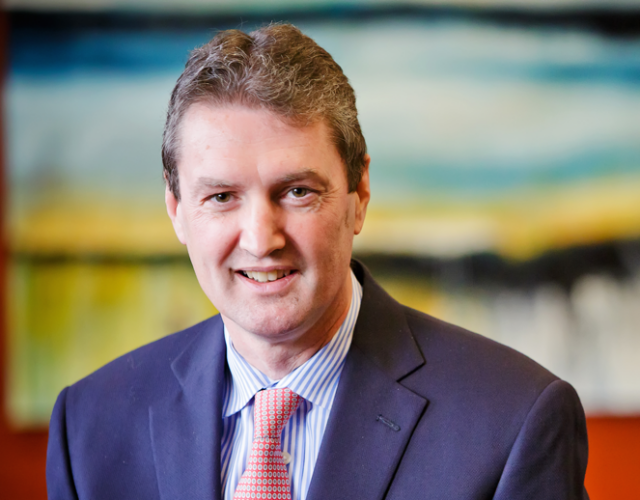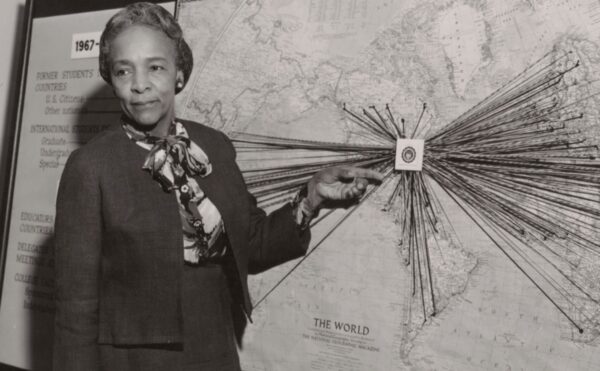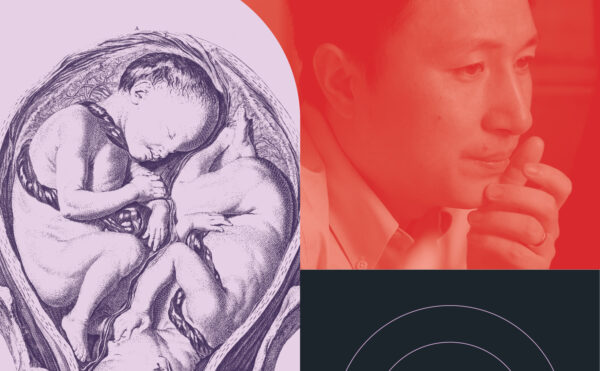Over the next several weeks, Distillations will be talking to people who have special insight into the coronavirus crisis—biomedical researchers, physicians, public health experts, and historians.
In this episode, we talk to Mark Stevenson, the chief operating officer of Thermo Fisher Scientific, an instrumentation company that has designed a diagnostic test for the novel coronavirus. The company is also working on a serology test, which will determine who has already had the virus. He tells us how the company developed those tests and the role they play in managing this pandemic.
Credits
Host: Alexis Pedrick
Senior Producer: Mariel Carr
Producer: Rigoberto Hernandez
Researcher: Jessica Wade
Audio Engineer: Jonathan Pfeffer
Transcript
Rigo: We’ll just get started with the fact that one of the biggest issues in taming this SARS-CoV-2 virus is in diagnostic testing. And can you tell us about Thermo Fisher’s role in creating diagnostic tests?
Mark Stevenson: Thermo Fisher’s role is early on we analyzed the novel coronavirus, and we developed a PCR-based test that was very sensitive and specific to detect the virus. We then scaled that capability up so that we’re now making more than 5 million kits per week and distributing them to labs in the U.S. and throughout the world.
Rigo: Is there currently more than one test that Thermo Fisher has developed, or are there more? I wasn’t really sure if, which one.
Mark Stevenson: So initially our focus has been on the PCR test, which is used to detect the virus and know if somebody has the virus or not. We’ve also developed in collaboration with the Mayo Clinic and WuXi a test that allows you to see if someone has had the virus, which looks at the antibody response.
Rigo: I see. So when you say the PCR test, that is the polymerase chain reaction test.
Mark Stevenson: Yes. So the way the test works is we analyze the genome of the virus, and then we pick certain areas in the virus. In our case, we picked three genes in the virus. We design very specific complementary parts of DNA that will attach onto those parts of the virus. This process is, you can think of sort of picking out fragments like you would with a magnet out of the virus, but they’re very specific to three genes in the virus.
And then the polymerase chain reaction, or short for PCR, amplifies that virus so that we can detect about 10 copies of the virus in a sample, which is a very low amount. Typically a patient that has the virus will have more than a thousand copies of the virus. So that means our test is not only very specific to this strain of the novel virus but also very sensitive to pick it up.
Rigo: I was reading that, is it called the TaqPath COVID-19 Combo Kit—the name of the test that Thermo Fisher has developed?
Mark Stevenson: So the name of the product is the TaqPath, which specifically works to pick up pathogens. In the past we developed this test for other viruses, such as MERS and SARS, Zika.
So over the years we’ve had a lot of experience. I joined the company more than 25 years ago, and during that time we’ve optimized the methods in which you only detect the virus that you’re looking for—and you don’t find other species of viruses in there. And also it copes with other contaminants, in this case where we’re swabbing or taking saliva. So we need to ensure that the reaction, the PCR reaction, can work even in the presence of other chemicals, contaminants, biological materials that otherwise would inhibit the PCR reaction.
Rigo: Right. I asked because one of the things that people might be hearing in the news is the fact that there’s questions about accuracy for tests. How do you see it from your end when people are talking about accuracy?
Mark Stevenson: Yeah. So clearly accuracy is incredibly important. We need to both have a test that is sensitive and specific, and tests do vary. So we’ve seen there are many tests on the market. They don’t all have the high level of sensitivity that’s necessary. And some miss the specificity. So having that high accuracy is incredibly important.
From an analytical point of view I’ll give you the data for Thermo Fisher’s test. We have more than 95% confidence that we can detect at 10 copies of the virus. So with that level of sensitivity, we have a high degree of confidence on the analytical sensitivity that more than 95% of the time you’ll be testing.
In fact, in data we’re finding much, much higher numbers. So in PCR testing it’s a very low, low number. We don’t have the exact data yet on what are true, false negatives that aren’t picked up by PCR.
I think we also need to be careful to distinguish the PCR tests from antibody tests, which also have had a lot of discussion. In that case we’ve got an additional challenge that some patients don’t even develop high antibody levels. So in detecting the level of antibodies, we need to look at that immune response because while the test may in analytical performance have a good performance, when you look clinically, it fails to pick up patients. That’s sometimes because the patient hasn’t had a high immune response. So these are some of the new things we’re still understanding about the virus and the immune response.
Rigo: I see. Yeah, the other test, I think, is what’s known as a serology test, which is detecting the antibodies. And you’ve also developed a test for that. Is that correct?
Mark Stevenson: Yes. So we’ve also developed a test for the serology. The test we’re developing was validated in the Mayo Clinic labs. Why we particularly liked that test is, we looked up many tests and worked with government agencies, was for the sensitivity and accuracy of that test, as it had been clinically validated in patients in the Mayo Clinic.
Rigo: To contextualize this for us, so what role does a serology test have in a pandemic? What role does it have? Why do we need to understand that you already had it?
Mark Stevenson: So the first is to answer the statistical question, as we think about how many people in the nation actually has had it. So it’s more on a population level. That we should do the surveys, as have been done in New York or Seattle, say, has it already been 5% or 20% of the population? So that’s important as we understand how far still we are away from herd immunity, which is generally accepted to be when a majority of the population has been affected and therefore may have importantly neutralizing antibodies to the COVID-19. So the first important part is really at a population level.
Rigo: I see. So if, I know that some places in the U.S. are starting to open up, including here in Philadelphia. And if I get a serology test, should I feel confident that I can potentially start interacting?
Like that’s just a question I have and maybe other people might have it.
Mark Stevenson: Yes. I think the question is a very normal question, and you know, there’s been this discussion of could the test give you like an immunity passport that you know you have it. At this time, you really shouldn’t do that. My advice would be, you want to continue with the social distancing, all the precautions.
If a colleague or you have symptoms, you should immediately get tested on the PCR test. And this is not as much for the validity of the serology test, but just, we don’t know yet. Even if you’ve had an infection, will they be neutralizing antibodies? Will they be able to stop you being reinfected again or reduce that? These are the clinical trials and science that’s now going on. And you see that in the work of the vaccines, understanding if you vaccinate, do we actually produce neutralizing antibodies and an immune response?
Rigo: So it’s not like a passport to return to your regular activities. It’s more statistical and to help us understand the virus.
Mark Stevenson: That’s correct. You know, unfortunately what we have to do at the moment is continue to social distance. While we can move out of the phase of lockdown, which was effective in reducing the transmission and spread, we all need to continue to keep the social distancing. And particularly from those who are most at threat, if they do contract the disease, who have underlying health conditions or maybe, you know, are out more, older, in the population.
Rigo: One of the things, going back to diagnostic, one of the things that we hear a lot here in the United States is this idea that there are not enough tests. And from your perspective what does that look like to you—that we don’t have robust testing? Like we hear that Korea has better, more and better, more tests than we do.
And could you kind of contextualize that? Is that—why don’t we have tests? I mean, it seems like something we should have.
Mark Stevenson: Yes. So I think when we compare with countries like Korea that it had previous infections with SARS and MERS. They were better prepared, I believe, when the infection first came out to rapidly scale their testing capacity in the labs. Here in the U.S., you know, what we believe is that as the virus came out, we needed to rapidly scale that testing.
And from Thermo Fisher’s point of view we’ve been scaling and ramping, firstly, reagent supply, initially to 5 million, now scaling the game towards 10 million a week, which I think will be good capacity for the U.S.
And we also needed to help each state and lab scale up their lab testing capabilities. So in the U.S. we have a few national labs, but each state, we’ve been working with the governor of each state to scale up their testing capacity. And we moved shortages: originally there were shortages in sample collection, in swabs, and other materials. We have been working with governors; we’ve recently announced, we’re scaling up our viral transport media, which is the liquid that’s used to transport it from the sample in Lenexa in Kansas, to scale up to millions per week.
So all of this has been part of scaling the response.
Rigo: I see, were we just not prepared to scale? I know that, this is not a point-the-finger kind of thing. I just really want to understand how can we have not had these tests?
Mark Stevenson: Well, the level of scaling is absolutely unprecedented because this is the first global pandemic of the modern era. With the level of transmission that occurred, it was exponentially growing before we went into the lockdown. So if you think of the normal scale of testing capacity, were we not set up for a modern global pandemic as a country? Absolutely not.
You know, part of being prepared for the next one is ensuring that we’ve maintained a level of surveillance. You know, part of, we’ve also learned lessons of how we scale and work with the government. We worked early with the regulatory authorities. The FDA has been very good in allowing this to come forward with approvals under the emergency use authorization, which allowed fast approval then of tests, our tests, other people’s tests, to scale our response. And all those are lessons I think we can take forward to the next pandemic.
Rigo: Right. So in fact you used the words emergency use authorization, approval. And could you tell us a little bit about that? I know that that’s something that I’ve heard.
Mark Stevenson: Yeah. So the FDA is authorized to make sure that all diagnostic products that are put on the market are safe and effective. And we work with the FDA—the normal period to submit that data, submit our clinical trials data. In a period of a pandemic, when an emergency is declared, they also put in place a faster approval set in an emergency use authorization, which allows you to submit your data with slightly less data than normally would be required to prove the validity of the test, to review that with accelerated timeframe so that during this emergency use, or period, we can get a diagnostic out for use in the market quicker.
In the case of our tests, we developed the test in January and February, and it allowed us then to submit the data during March. So we got approval in the middle of March under this emergency use authorization.
Rigo: So just to clarify, the test, the diagnostic test, it didn’t exist in January. So like that was when it was developed?
Mark Stevenson: That was when the test was designed because it had to be very specific for this virus to detect three genes in this virus. So it didn’t exist before we knew the DNA sequence, and then we could design it.
Rigo: So as soon as reports started coming out of China is when you went to work on designing it.
Mark Stevenson: That’s correct. So from early in January, we looked at the DNA sequences that were getting published and then started to design the assay that could detect it. And then of course had to validate that and be confident we could produce that robustly at scale.
Rigo: I see. Did you expect that in general to become what it is now?
Mark Stevenson: We expected it to be important, but not of the scale. It’s only as the weeks and months have gone on that we have a clear point of view that this is going to continue to need to test in large volumes, in order not only to test the people who have been sick and in hospital but now to open back up the economy.
So we’re seeing increasingly employers want to do testing, sports groups want to do testing. And everyone wants to be able to monitor and track any outbreaks that they have within the communities.
Rigo: I see. So another thing that people are hearing about is having a rapid test. When do they get the results? And I heard that some results can take up to four to six days or even longer. Can you tell us how your test fares, and is it unrealistic to expect instantaneous results?
Mark Stevenson: So the speed of turnaround in the test is certainly important. And ideally you’d want to get testing back within a period you can test, trace, and isolate those individuals. So ideally a lot of people discussed within 48 hours. But the time in the lab actually typically takes only three to four hours to run this test, and you can run them massively in parallel.
So the part that we need to speed up is getting the backlog down. So make sure when the test comes in, it can get run straight away. And then the logistics, to make sure it can get taken from the testing point, wherever that is taken—in the future maybe also including home sampling—sent to the lab and testing. We also see point-of-care testing that can be tested typically in a time perhaps of 30 minutes. The challenge sometimes in those tests is they’re typically not as sensitive or accurate. And so you may get an increased number of false negatives. So the test gives you a negative because it’s not as sensitive, but that may be a tradeoff that we’re willing to live with in terms of speed.
Rigo: I just had a clarifying question. Where are Thermo Fisher’s tests sent to? Are they like, do we find them in a hospital? Are they the ones that are in the parking lots of shopping centers where they do testing? Where are they distributed?
Mark Stevenson: So our tests are distributed to the laboratories running them, and that may be in a hospital, it may be in a CDC lab, it may be in a commercial testing lab, typically in those labs. And then the collection point would be what you see from a carpark, selecting the swab or in a hospital. And those are then sent in to the central labs. So we’re serving the labs, and those labs are getting the tests and the samples sent in to them from the collection points.
Rigo: I see. So one of the things that I keep hearing from people over this series of interviews that we’ve done on this is that inevitably there will be another pandemic. What can countries and then private industry companies like Thermo Fisher do to prepare for the next one?
Mark Stevenson: Yes. In terms of preparedness I think there are a couple of things we have to have in place. In terms of testing, you need the infrastructure for surveillance. So this instrumentation that does the testing needs to be positioned no different than we prepare for fire or earthquakes. We have surveillance systems in place that can give us detection. So that’s the first point.
The second point is some preparedness that allows us to move quickly to get tests approved. So knowing there will be novel viruses needs a regulatory process of flexibility to scale up. And thirdly, when we think about vaccines and therapies, these are areas that we need infrastructure that probably private industry wouldn’t always prepare for.
And so we need some level of government support, in some level of government, either infrastructure or stockpiling or public-private partnerships, that allow us to work together and have a level of infrastructure that can be used to respond quickly to a pandemic just as you would to other crises.
Rigo: I was watching a YouTube video on your channel, and in it, there’s talk about coronavirus and the different ways that instrumentation by Thermo Fisher was used, from the microscope to detect it, to the reagent and assays that are sent to test, to the microscope that was used to make 3-D modeling.
What role does instrumentation play in a pandemic? It seems like it’s one of those things we take for granted.
Mark Stevenson: Oh, very important in a pandemic is the basic science understanding of what we’re dealing with. I sometimes hear comments that we can’t see the threat, it’s invisible, but in fact, if you use a strong enough microscope—many researchers use the electron microscope—you can actually see the virus, visualize it, at a 3.0-Angstrom level to view the virus. And not only see the structure then of a virus, but you can see the binding to therapies, examine it, and that allows you to further get an understanding of how we can develop therapies or even serology diagnostics.
Rigo: It’s very interesting how the virus has affected people in many different countries. Some fare better than others. You’re in the U.K. now. You were in the U.S. here. What are you kind of seeing from different countries?
What are you, what are some takeaways that you see that maybe countries do differently or that kind of interested you?
Mark Stevenson: Well, it’s a good point. I mean, one way the virus is the same, with some adaption of genetic mutations. Or actually what’s certainly different to start is that it’s affecting countries in pretty much the same way. I think in terms of country response, you know, as I mentioned, countries that had a different infrastructure in place, we discussed Korea, were able to respond in a different way. We suddenly see governments heavily involved. So I’ve been involved in a number of governments in Europe. For example, Germany has scaled up their infrastructure in tests in a very strong way. In the U.K., they decided to build up three main high-throughput labs to cover the country, where Thermo Fisher supported those three national labs.
Well, then we see other countries that are taking a different approach. I think Sweden has been mostly in the news. And if you look at the data today of the four Scandinavian countries, you see the difference of taking an approach with a lockdown or not just from the escalation in cases. So I think you can certainly see the different response and so far different outcomes from the different government responses.
Rigo: Do you want to add something that I didn’t ask? Or is there something I didn’t ask that you wish I had asked?
Mark Stevenson: No, I think you covered it. I mean, it’s an unprecedented time of response to this pandemic. Thermo Fisher is certainly mobilizing resources against it. We’re starting with the basic research, moving on to diagnostic testing, and that we believe will continue. This isn’t something that stops. We’re also all looking forward to helping accelerate the vaccine and therapies, which is really where we see—at least the end to this first global pandemic will be when we all have a vaccine.
Rigo: Great. Thank you so much. This was great. I really appreciate you taking the time to talk to me.
Mark Stevenson: You’re very welcome. Good discussion and great questions.




